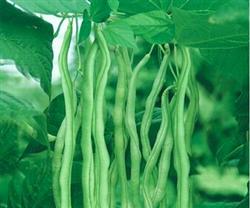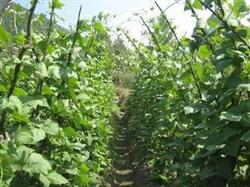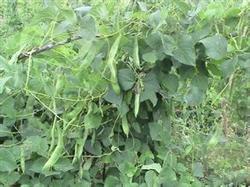High-yield cultivation techniques of kidney bean

Kidney beans are native to Mexico and America, and have spread all over the world since the 17th century. They are also known as flowered kidney beans. Cultivation has a long history, due to the large export volume, the area is expanding year by year. It is rich in nutrition and high in protein, which is not only vegetables but also grain, pastries and bean stuffing. It is an important agricultural and sideline product for export. First, the morphological characteristics of kidney bean kidney bean root system is developed, generally annual, in the winter is not too cold areas can become perennial. The root system is developed, the soil is deep, and it is more resistant to drought. The stem is trailing, the growth is prosperous, the branch force is strong, the stem length is above 4 meters. Leaves green, alternate, Ternate, heart-shaped, cotyledons not unearthed. Flowers are wormleaf-shaped flowers, racemes, pedicels 15-18 cm long. Blossom more, pod less. Pods green, hard, edible seeds, yellow when mature. The seeds are kidney-shaped, white seeds with white flowers and flower seeds with red flowers. The weight of a thousand seeds is 8-1500 grams. Second, the type of kidney bean, there are two types of kidney bean, namely big white kidney bean and big black kidney bean. The seeds with white flowers are white seeds, called big white kidney beans, and the seeds with red flowers are mostly purple black patches or markings, called big black kidney beans or big flowered kidney beans. Because the two kinds of flowers and colors are bright and beautiful, they are available for viewing, so they are collectively referred to as looking at flower beans. Third, kidney bean requirements for environmental conditions 1, temperature: kidney bean is suitable for planting in temperate and tropical high-altitude areas, more resistant to cold, avoid high temperature. It was frozen only when the temperature was below 5 degrees, and the aboveground part died in case of frost. Growth and development requires frost-free period of more than 120 days, the most suitable germination temperature is 20-25 ℃, the suitable growth temperature is 18-20 ℃, it is difficult to pollinate above 30 or below 15. It is especially suitable for planting in the plateau and mountainous areas of Yunnan. 2. Light: it belongs to cross-pollination, short-day crops, and likes plenty of sunshine. The shorter the sunshine time is, the more sunny it is, the earlier the kidney bean blossoms, pods and ripens. On the contrary, the sunshine is prolonged, the sun is insufficient, kidney beans blossom, pod, mature time delayed, branches and leaves grow, even can not blossom and bear pods. 3. Moisture: kidney bean requires sufficient and uniform water during the whole growth period, and the flowering and podding stage is the period when the most water is needed. At this time, if there is a lack of water, it will have a great impact on the yield. In Yunnan and Guizhou, natural rainfall can usually meet the requirements without irrigation. 4. Soil: kidney bean has a well-developed root system, which is suitable for planting in medium soil with deep soil layer and good drainage, but not suitable for soil with viscous weight and poor drainage. The pH of soil should be neutral and slightly acidic. Fourth, the main points of cultivation 1. Grasp the best season and sow seeds at the right time. It can be sowed when the soil temperature is 10 degrees. Generally, it can be sowed from April to June. The sowing amount per mu is 6.5-8 kg, and the sowing depth is 10-15 cm. 2. Apply sufficient base fertilizer and topdressing at the right time. About 1500 kg of agricultural fertilizer is applied per mu, and 40-50 kg of compound fertilizer (30 kg of phosphate fertilizer and 10-15 kg of potash fertilizer) is used as base fertilizer. Topdressing should be applied twice at the initial flowering stage and podding stage, 10-15 kg per mu each time. 3. Reasonable close planting. It is required to cultivate high soil moisture in single or double ridges, with a row spacing of 0.8-1 m and a plant spacing of 0.35-0.45 m. Sow 2-3 seeds per pond and 1500-2200 ponds per mu. It can be purebred or interplanted with corn and potato (2). 4. Build a fight and go to the top. When the height of the main stem is 30-40 cm or 5-6 true leaves appear, the height of the frame is more than 2 meters, and the technical head is removed when the plant height is about 50 cm. Through the removal of new branches for many times, the plant forms a short shrub-like shape, reduces the height and increases the number of flowering and pods. 5. Timely control of diseases, pests and weeds (wilt disease, powdery mildew, virus disease, aphids, pod borer, red spider, mung bean weevil).
- Prev

How should kidney bean red root be solved?
Kidney beans are native to Mexico and America, and have spread all over the world since the 17th century. They are also known as flowered kidney beans. Cultivation has a long history, due to the large export volume, the area is expanding year by year. It is nutritious, the protein content is high, namely the vegetable is the grain, but also can make the cake and the bean filling, is the export earns the foreign exchange.
- Next

Control of main Diseases and insect pests of Kidney Bean
See the symptoms of melon white silk disease: dark brown at the base of the stem, dense white filamentous mycelium on the surface, and tea-brown round sclerotia on the mycelium in the later stage. Disease regularity and control methods: refer to the distribution of Sclerotinia sclerotiorum disease of melon and host plant: it is distributed all over the country. In addition to harming beans,.
Related
- The first cup of black tea in spring, the flavor and history of tea gardens in Kenya, Africa
- The computer can not only choose potatoes, but also grow tea rice. AI will grow winter oolong tea champion.
- It is not only the inflated tea bitten by insects, but also engraved with the four seasons tea in Beipu.
- The Oriental Beauty Tea Festival in Zhuxian County takes the stage at the weekend to experience the plus-size feast of oil tea.
- & quot; Oriental Beauty Tea & Exploration of Emei in Hsinchu, the hometown of quot;
- The new variety of strawberry "Tainong 1" dessert is the first choice with mellow aroma. Crimson gorgeous
- History of Tea in Taiwan: from Wild Inner Mountain to Export Tea Garden
- Two types of Taiwan Oriental Beauty Black Tea won the British three-Star Award for Childhood Tea Xiang Zhang Jiaqi changed from pilot to champion tea maker.
- Banana species and varieties: the planting history of Taiwan Xianren banana and dwarf banana is long, is banana disease resistant?
- Coffee planting Technology: Qianjie Coffee from Seedling to harvesting

